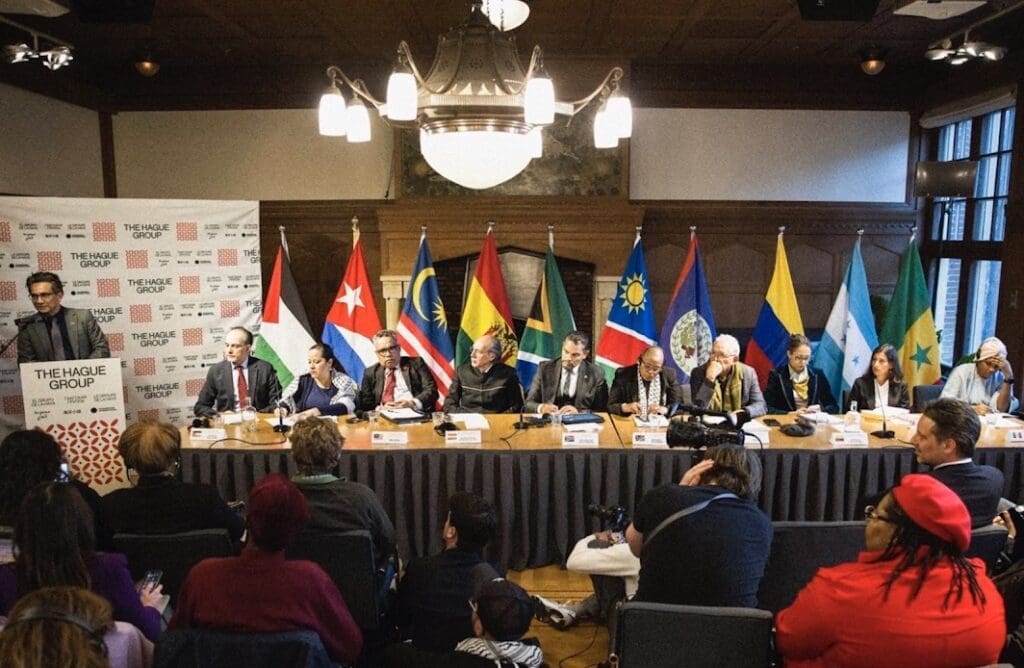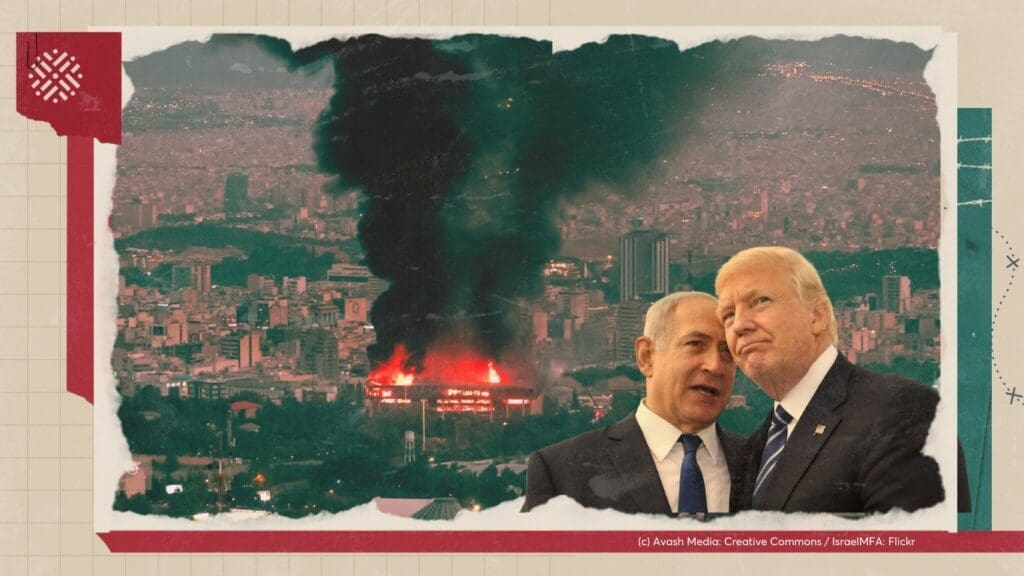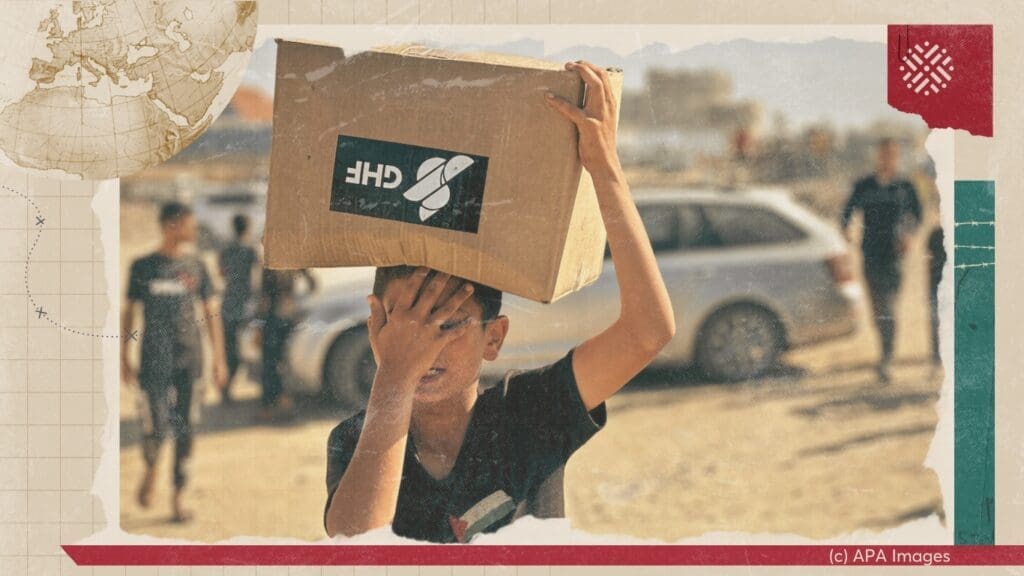- Topics
-
Topics
See our analysis on civil society and how it shapes culture, politics, and policies
Read our insights on the shifting political landscape and what it means for Palestine
Learn more about the policies and practices shaping the Palestinian economy
Strengthen your understanding of the unique conditions for Palestinian refugees across the Middle East
-
- Analysis
-
Analysis
In-depth analysis on existing or potential policies that impact possibilities for Palestinian liberation.
Insights and perspectives on social, political, and economic questions related to Palestine and Palestinians globally.
Concise analysis into a specific policy, its background and implications.
Commentary that brings together insights from multiple analysts.
Compilations of past Al-Shabaka works surrounding a specific theme.
Longer-form, ad hoc projects that seek to confront research questions outside the scope of our regular analysis.
A policy-driven research initiative by Al-Shabaka: The Palestinian Policy Network.
Our monthly webinar series that brings together Palestinian experts.
Featured
The Israeli regime’s ongoing genocide in Gaza has exposed the failure of international legal frameworks to protect civilians, marking an unprecedented breakdown in the protective function of international law. While the Genocide Convention obligates states to prevent and punish genocide, and the Geneva Conventions establish protections for civilians under occupation, these mechanisms have proven powerless without the political will to enforce them. In this context, eight Global South states—South Africa, Malaysia, Namibia, Colombia, Bolivia, Senegal, Honduras, and Cuba—have launched the Hague Group, a coordinated legal and diplomatic initiative aimed at enforcing international law and holding the Israeli regime accountable. This policy memo examines the group’s efforts to challenge entrenched Israeli impunity. It highlights the potential of coordinated state action to hold states accountable for violating international law, despite structural limitations in enforcement. Munir Nuseibah· Jul 8, 2025On Thursday, June 19, 2025, Israeli Prime Minister Benjamin Netanyahu stood in front of the aftermath of an Iranian strike near Bir al-Saba’ and told journalists: “It really reminds me of the British people during the Blitz. We are going through a Blitz.” The Blitz refers to the sustained bombing campaign carried out by Nazi Germany against the UK, particularly London, between September 1940 and May 1941. With this dramatic comparison, Netanyahu sought to elicit Western sympathy and secure unconditional support for his government’s latest act of military escalation and violation of international law: the unprovoked bombing of Iran. This rhetorical move is far from new; it has become an enduring trope in Israeli political discourse—one that casts Israel as the perennial victim and frames its opponents as modern-day Nazis. Netanyahu has long harbored ambitions of striking Iran with direct US support, but timing has always been central. This moment, then, should not be viewed merely as opportunistic aggression, but as part of a broader, calculated strategy. His actions are shaped by a convergence of unprecedented impunity, shifting regional dynamics, and deepening domestic political fragility. This commentary examines the latest escalation in that context and discusses the broader political forces driving it.
Munir Nuseibah· Jul 8, 2025On Thursday, June 19, 2025, Israeli Prime Minister Benjamin Netanyahu stood in front of the aftermath of an Iranian strike near Bir al-Saba’ and told journalists: “It really reminds me of the British people during the Blitz. We are going through a Blitz.” The Blitz refers to the sustained bombing campaign carried out by Nazi Germany against the UK, particularly London, between September 1940 and May 1941. With this dramatic comparison, Netanyahu sought to elicit Western sympathy and secure unconditional support for his government’s latest act of military escalation and violation of international law: the unprovoked bombing of Iran. This rhetorical move is far from new; it has become an enduring trope in Israeli political discourse—one that casts Israel as the perennial victim and frames its opponents as modern-day Nazis. Netanyahu has long harbored ambitions of striking Iran with direct US support, but timing has always been central. This moment, then, should not be viewed merely as opportunistic aggression, but as part of a broader, calculated strategy. His actions are shaped by a convergence of unprecedented impunity, shifting regional dynamics, and deepening domestic political fragility. This commentary examines the latest escalation in that context and discusses the broader political forces driving it. Yara Hawari· Jun 26, 2025Launched on May 26, 2025, and secured by US private contractors, the new Israeli-backed aid distribution system in Gaza has resulted in over 100 Palestinian deaths, as civilians navigated dangerous conditions at hubs positioned near military outposts along the Rafah border. These fatalities raise grave concerns about the safety of the aid model and the role of US contractors operating under Israeli oversight. This policy memo argues that the privatization of aid and security in Gaza violates humanitarian norms by turning aid into a tool of control, ethnic cleansing, and colonization. It threatens Palestinian life by conditioning life-saving aid, facilitating forced displacement, and shielding the Israeli regime from legal and moral responsibility. It additionally erodes local and international institutions, especially UNRWA, which has been working in Gaza for decades.
Yara Hawari· Jun 26, 2025Launched on May 26, 2025, and secured by US private contractors, the new Israeli-backed aid distribution system in Gaza has resulted in over 100 Palestinian deaths, as civilians navigated dangerous conditions at hubs positioned near military outposts along the Rafah border. These fatalities raise grave concerns about the safety of the aid model and the role of US contractors operating under Israeli oversight. This policy memo argues that the privatization of aid and security in Gaza violates humanitarian norms by turning aid into a tool of control, ethnic cleansing, and colonization. It threatens Palestinian life by conditioning life-saving aid, facilitating forced displacement, and shielding the Israeli regime from legal and moral responsibility. It additionally erodes local and international institutions, especially UNRWA, which has been working in Gaza for decades. Safa Joudeh· Jun 10, 2025
Safa Joudeh· Jun 10, 2025
-
- Resources
- Media & Outreach
- The Network




What’s Stopping the 3rd Intifada?
The repeated failure of bilateral negotiations brokered by the United States to halt and reverse Israel’s aggressive colonialism regularly fuels speculation about a 3rd Intifada (uprising) against the Israeli occupation. However, a 3rd Intifada depends on the interaction of two sets of processes: the collective repressive and dehumanizing conditions of life under occupation, on the one hand, and, on the other, the changes that have taken place within Palestinian society in the occupied West Bank and Gaza Strip (WBG), as well as the overall Palestinian political movement.1
Processes Driving a 3rd Intifada
Under cover of the Oslo Accords, Israel has engineered a tight apartheid system in the WBG marked by the national subjugation of Palestinians, the denial of their collective rights, their humiliation, and the pauperization of an increasing number. The mechanisms used to maintain this collective subjugation are well known: control and colonization of land and other natural resources; control of borders, external trade, and the supply of water and electricity; daily violence by Israeli settlers against Palestinian civilians and their property; and disregard of the sanctity of the Muslim and Christian holy places, among others.
In addition, as a settler colonial state, Israel has annexed Jerusalem and its environs and is emptying both Jerusalem and the Oslo-created Area C of its indigenous Palestinians while settling them with Israeli Jews. Twenty years after Oslo, one in every four persons in the West Bank is a settler. Israel has and continues to deliberately fragment the WBG into “Bantustans” through its system of Israeli-only bypass roads connecting Israeli settlements directly to Israeli cities and towns within the Green Line, the construction of the Separation Wall, checkpoints and roadblocks, and the remorseless siege on Gaza.
The Israeli occupation has also created and maintained conditions of economic and financial dependency of the WBG on external aid and transfers, and by so doing enforced a rentier economy on the two Palestinian self-governing authorities in the WBG along with high rates of unemployment. Palestinians are continuously exposed to high risk situations, including restrictions on movement, home demolitions, curfews and closures, detention and imprisonment, assassinations, military incursions, and outright invasions, as happened in the West Bank in 2002 and in the Gaza Strip in 2008-2009 and again in 2012. The 1.8 million Palestinians imprisoned in Gaza also face cuts in electricity supply, scarcity of potable water, and severe restrictions on the supply of fuel, basic construction materials, medicines, and other goods and services needed for basic survival.
These processes have forced Palestinians within and outside historic Palestine to recognize that, for the foreseeable future, no real prospect exists of an independent sovereign state with East Jerusalem as its capital or any form of meaningful self-determination, let alone a significant implementation of the right of return for Palestinian refugees to their original homeland – a realization reinforced by the ignominious failure in April 2014 of the negotiations brokered by US Secretary of State John Kerry.
It should be noted that the Oslo Accords did not mark a change in Israeli policy towards the Palestinian people in the territories occupied in 1967. Rather, they proved to be a continuation of Israel’s colonial policy after its creation in 1948 and the Israeli practices of depopulating the indigenous Palestinian population and settling of Israeli Jews, home demolitions, and other human rights violations on both sides of the Green Line.
The processes described above would seem to create the conditions for a 3rd Intifada. However, other powerful inter-related processes in the WBG counteract them: The spread of individualism (or individualization), the decline of political mobilization, and the accentuation of socio-economic inequalities.
Individualism and the Loss of a Political Anchor
The spread of individualism means that more and more Palestinians are legitimating, promoting, and protecting their personal interests and concerns above the collective interests and concerns of the community. This is the outcome of a number of factors.
The first is the adoption of a neoliberal economic regime by the Palestinian Authority (PA), which comes as no surprise because the PA was established at the height of global neoliberal era and was promoted by the World Bank and the International Monetary Fund. The neoliberal approach won the support of the PA’s major donors as well as many Palestinian NGOs that depend on foreign aid.
Under the neoliberal regime, the private sector was granted the determining role in shaping the Palestinian economy and the PA’s dependency on external aid and on Israeli tax transfers was cemented. This dependency has made the PA vulnerable to political pressure and made the employees of its large public sector wary of any change that could jeopardize their sources of livelihood.
Individualism has also been the outcome of the enlarged role of NGOs in the WBG in the wake of the establishment of the PA in 1994. Many NGOs, particularly the larger NGOs, are dependent for their functioning on donor money despite its clear neo-liberal political bias and donor priorities to maintain the Oslo-generated “peace process” at any cost. The significant expansion of the number and types of NGOs has meant, in most cases, the substitution of representative and voluntary associations by professionalized associations with no mandate to represent the interests of any specific constituency.
A third factor related to the process of individualization has been the decline in the influence and credibility of political organizations and the buildup of the PA bureaucracy and formal institutions under the illusion that this would soon lead to an independent Palestinian state. The largely egalitarian political culture “of brothers and comrades” and the relatively easy access to leaders by the rank and file that existed before the Oslo Accords has been replaced by pseudo-state institutions with their rigid hierarchical structures and discourse. There are now ministers, director generals, and other civilian and military ranks, each with its own special privileges and job description. This has significantly diminished the capacity of political organizations – including the largest two Palestinian movements, Fatah and Hamas – for popular mobilization on national issues. Most of the cadres of Fatah and Hamas have been absorbed into the formal bureaucratic institutions established by both movements in the West Bank and Gaza.
The marginalization of Palestinian national institutions is most clearly seen in the outright sidelining of the Palestine Liberation Organization (PLO) institutions that had previously represented the Palestinian communities inside and outside of historic Palestine. The loss of PLO institutions included most, if not all, popular organizations and trade unions that have now been estranged from much of their rank and file constituencies in the WBG and among other Palestinian communities. Not only have Palestinians lost the PLO as their all-embracing, representative national institution, they have ended up with a divided PA with two self-governing authorities under settler-colonial occupation and a suffocating siege. In effect, the Palestinians have played into and suffered from the Israeli strategy of fragmentation of the Palestinian people, geographically and institutionally.
The net result is the loss of a political anchor and a mobilized population that could lead a new Intifada against the settler-colonial state. The political organizations, trade unions, and mass organizations were essential to the outbreak of the 1st Intifada, and the ability of the population to sustain it and their loss undermines the potential for a 3rd Intifada.
The New Middle Class and the Workers: No Intifada in Sight
The establishment of the PA led to significant class transformations in the WBG. Structural inequalities sharpened between regions, cities, villages, camps, and individual families. A sizeable middle class emerged that largely depends on employment in the PA’s various ministries and security apparatuses, donor agencies, NGOs, and the increasingly influential profit-oriented private sector, including in new economic sectors, such as communications, electronics, insurance, banking and finance, advertisement, and marketing. This coincided with a huge expansion in the field of education at all levels and in health care, in addition to a noticeable increase in the number of professionals, such as lawyers, engineers, and architects, among others.
This new middle class has an obvious interest in not rocking the boat. An increasing proportion of the new middle class is now entangled in bank loans taken out for new homes, cars, furniture, and the like. Any stoppage in salaries from the PA or other employers will leave this large segment of the population highly exposed as has happened on more than one occasion since the 2nd Intifada. Much of the Palestinian middle class in the WBG will be reluctant to engage in an uprising so long as it fears that it has its livelihood to lose.
This does not of course mean that lower income workers in the WBG are in a position to launch an Intifada as the Tunisian workers had done through their powerful trade union movement in 2011. True, like Tunisians before the uprising, they have less job security, lower wages, few of the social entitlements of the new middle class, and higher unemployment rates than any other group other than university graduates. But more crucially, Palestinian workers are scattered amongst tens of thousands of small and very small enterprises, and the majority of them are not unionized; in fact, the middle class (e.g. teachers, lawyers, engineers, public employees, UNRWA employees) is more unionized than the working class. Moreover, about 10% of the labor force in the West Bank continues to be employed in Israel and its settlements as manual labor, according to Palestinian Central Bureau of Statistics.
It is worth noting that class and status distinctions based on wealth and position have never been as glaring as they have come to be in recent years, nor has the conspicuous consumption of expensive cars, villas, shops, restaurants, and five star hotels. In the 1st Intifada, the glaring distinctions were largely between the occupier and the occupied. Now, they are very noticeable between different segments of the occupied and besieged population.
Some analysts believe that the collapse of the PA, whether as a result of a Palestinian decision to dissolve it or under the impact of Israeli and US pressures, will lead to a new Intifada. Other analysts have assessed the repercussions of a PA collapse and provided recommendations to deal with different scenarios. It remains an open question as to whether a PA collapse would eventually lead to another Intifada or rather to deliberate actions to challenge and reverse the limitations on collective action.
An Intifada against the PA itself in its West Bank and Gaza Strip configurations is unlikely, partly because the national question continues to predominate over dealing with local matters. Polls suggest the existence of public support for a continuation of the PA despite the mixed feelings of those polled. A majority of Palestinians in the WBG believe that Palestinian institutions are corrupt: 77% for institutions in the West Bank and 68% for institutions in the Gaza Strip. However, most do not want to see the PA’s dissolution.
What we are more likely to see is a continuation of demonstrations and other attempts to exert pressure on the two self-governing authorities, such as protests against high prices, unemployment, and delays in salary payments. These are not likely to accelerate into a new Intifada against the two Palestinian authorities. For one thing, such action will be seen as playing into the hands of Israel, and for another, both authorities are well equipped (security wise) to repress such attempts. It is worth noting that the two rival authorities have encouraged protests in each other’s territory despite many agreements to end their division. As for the outcome of the 2014 April agreement to end the division, that is still anybody’s guess.
How Bleak Is the Future?
For the near future, Palestinians under occupation will continue to be buffeted by the need for collective action for freedom, self-determination, and sovereignty and the counter-forces created by the neoliberal economy, aid dependency, and social and political atomization. This reality is supported by the divergent views expressed by political elites as well as the general public. For example, a public opinion poll in November 2013 showed that 60% of those surveyed in the WBG expected a 3rd Intifada in the near future, but only 29% said that they would support it. As for an uprising against the PA, a September 2013 poll of Palestinian youth – the sector expected to be most in favor of an uprising – revealed that only 30% of Gaza youth said they supported the outbreak of such an uprising in the Gaza Strip, while 63% said that they opposed it. In the West Bank, only 21% of youth supported an uprising against the PA there while 72% opposed it.
Israel’s repression, discrimination, and humiliation of Palestinians, and its pillage and denial of their historic, national, and civic rights have never been as great as they are today. Meanwhile, negotiations have reached a dead end and military resistance has shown its limits. Nevertheless, it is clear from the above analysis that the geographic and political fragmentation of the Palestinian people, the growth of individualism, the heightened inequalities in the WBG promoted by the neoliberal economy, and the dependence on external aid and transfers greatly constrain the emergence of the collective action that is necessary to help end the Israeli occupation.
We are more likely to see a continuation of the protest and resistance pattern witnessed in the last two or three years: Localized confrontations with the colonial power and its settlers in the West Bank and intermittent military confrontations in the Gaza Strip, along with outbreaks of outrage against the overall situation in both territories. The situation will remain highly volatile and explosive but lacking the organizing agency necessary for a mass uprising.
A change in the present dynamic can only come through the possession of organizational instruments for collective action against the settler-colonial power by Palestinians living under occupation as well as the Palestinian citizens of Israel and Palestinian refugees and exiles. This requires a democratic and representative process aimed at rebuilding Palestinian national institutions, particularly those of the PLO and its popular and professional organizations. It also requires the development of a clear national strategy that engages all parts of the Palestinian people and transcends the logjam created by the narrow-minded focus on negotiations and/or military confrontation as the only avenues available to further Palestinian rights.
Indeed, Palestinians must understand resistance to mean a holistic strategy that goes beyond military resistance and covers all forms of engagement, including legal, diplomatic, political, cultural, and economic avenues, as well as measures to boycott, divest from and sanction Israel as advocated by the BDS movement. As for the private sector, it needs to be oriented so that it promotes an economy capable of functioning under and resisting the Israeli occupation while meeting the needs of the WBG Palestinians in their struggle for survival.
There is also an obvious and urgent need for a strategy to dismantle, without hesitation, the colonial power structures created by Oslo and to radically redefine the functions of the PA – if a national decision is taken to keep it in one form or another – and, in particular, the role and functions of its security forces, in line with a comprehensive national strategy guided by a reformed and restructured PLO. Moreover, Palestinian political parties need to regain their representativeness and ability to mobilize the capabilities of the Palestinian people. If there is to be a new Intifada, its objectives, strategies, forms, and locations must be the subject of national deliberation and support for it to achieve its aims.
Jamil Hilal
Latest Analysis
The Hague Group: Mobilizing International Law for Palestine
Timed for Impunity: Israel’s War on Iran
Outsourcing Occupation: US Private Contractors in Gaza
We’re building a network for liberation.
As the only global Palestinian think tank, we’re working hard to respond to rapid developments affecting Palestinians, while remaining committed to shedding light on issues that may otherwise be overlooked.